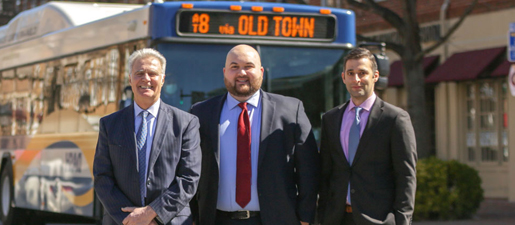A common question prospective and current clients ask us is how an actual civil trial proceeds and what occurs during the trial. While each of the parts of a trial discussed below will be addressed in greater detail in blogs to come, this overview provides a quick summary for a basic understanding. Keep in mind that at the trial of a typical personal injury case, the plaintiff, the person bringing the lawsuit, bears the burden of persuading the jury that the defendant was negligent (i.e., careless) and that careless conduct caused the plaintiff injury.
Jury Selection
After the trial judge greets the prospective jurors summoned to the courthouse for the trial and explains the basics of the case, the lawyers for the parties have the opportunity to question the prospective jurors. The questioning of the jurors is known as “voir dire,” Latin for “speak the truth.” Through questioning the potential jurors, the lawyers’ goal is to learn of any biases, preconceived beliefs, or life experiences that would make it difficult for a person to hear the evidence, be instructed on the law, and decide the case impartially and fairly to both parties. After the questioning, the lawyers for the parties have the opportunity to communicate to the judge those jurors that are acceptable and those that are not. Once the jury is selected, they are sworn by the judge to apply the law to the evidence as they determine it and to return a verdict at the conclusion of the case.
Opening Statements
After the jury is sworn by the judge, the lawyers for the parties have the opportunity to address the jury by giving an opening statement. Think of the opening statement as a road map, where the lawyers explain to the jury what the case is about, what issues the jury will have to decide, and what evidence will be presented.
Plaintiff’s Case in Chief
As the burden of proof is on the plaintiff, the party bringing the lawsuit, the plaintiff presents their evidence first. This is done through the direct examination (questioning) of witnesses by the plaintiff’s lawyer and the introduction of exhibits such as photographs into evidence through the witness on the stand. The defense has the opportunity to cross-examine each witness to discredit, undermine, or limit the witnesses’ testimony on direct. At the conclusion of presenting all of the intended evidence, the plaintiff rests their case.
Motion to Strike
After the plaintiff rests his case, the defense will make a Motion to Strike (dismiss) the case arguing that the plaintiff failed to present sufficient evidence to satisfy the legal requirements to prove their case. In most cases, a Motion to Strike is perfunctory and is denied by the trial judge.
Defense Case
Assuming the Motion to Strike is denied, the defense then presents its case by directly examining witnesses and introducing exhibits with the intention of countering, undermining, or disproving the plaintiff’s evidence. The plaintiff’s lawyer has the opportunity to cross-examine each defense witness to undermine, discredit, or disprove that evidence. At the conclusion of their evidence, the defense rests its case.
Rebuttal Testimony
Since the plaintiff bears the burden of proof, the plaintiff has the opportunity to present additional witness testimony and exhibits after the defense rests to rebut any new matters presented by the defense in its case. After the plaintiff has concluded presenting any rebuttal evidence, they again rest their case. That ends the presentation of evidence by either party.
Instructing the Jury
Having heard all the evidence, the next part of the trial is for the jury to be told the law that the jury is to apply after determining the facts from the evidence presented. The law provided by the judge is known as the jury instructions and is chosen by the lawyers for the parties. If the lawyers cannot agree on a particular instruction, the party asking that it be given will argue to the judge, outside the jury’s presence, why it should be given, and the opposing lawyer has the opportunity to argue against it. The judge ultimately decides whether a particular instruction will be given to the jury. The judge then instructs the jury by reading each instruction to the jury. A copy of the jury instructions is also given to jurors for their reference while deliberating.
Closing Arguments
After being instructed on the law that governs the case, the lawyers for the parties have another opportunity to directly address the jury with a closing argument. The plaintiff goes first, and the plaintiff’s lawyer will walk the jury through the evidence and the law to prove that the plaintiff has met its burden of proof to prevail and that the verdict should be returned in the plaintiff’s favor. The defense then has the opportunity to address the jury and to argue, also through a review of the evidence and the law, why the plaintiff failed to meet its legal burden and that the verdict should be returned in favor of the defense. As the plaintiff has the burden of proof, the plaintiff has the opportunity to do a short rebuttal closing argument to rebut the defense’s closing argument.
Jury Deliberations
After listening to the closing arguments, the jury retreats to the jury deliberation room. They are provided with a copy of the jury instructions and all the admitted exhibits. Their first duty is to select a foreperson to guide their deliberations. After that, they are to consider the evidence, apply the law as instructed by the judge, apply their common sense, and return a unanimous verdict, which is recorded on a verdict form provided by the judge, which has been agreed to by the parties.
Returning the Verdict
Having reached a verdict, the jury is brought back into the courtroom, and the foreperson reports the verdict by reading the verdict form. The lawyers then have the opportunity to have the judge poll each juror if the verdict reported is their verdict. Having reported the verdict, the judge thanks the jurors for their service and releases them from duty.

